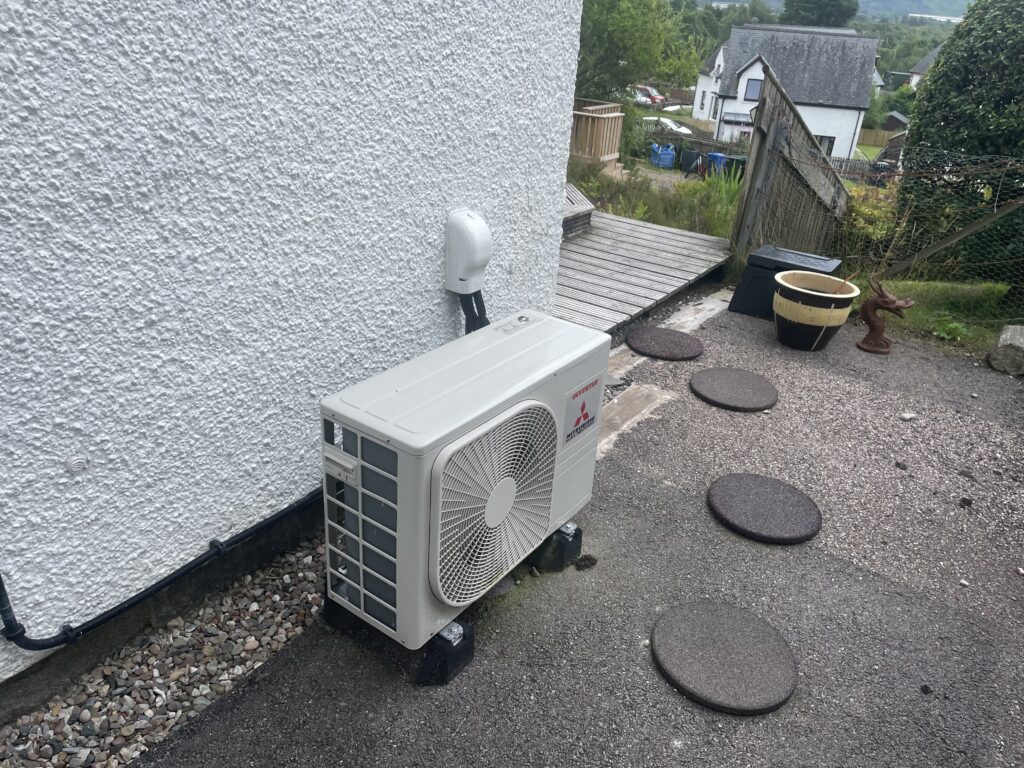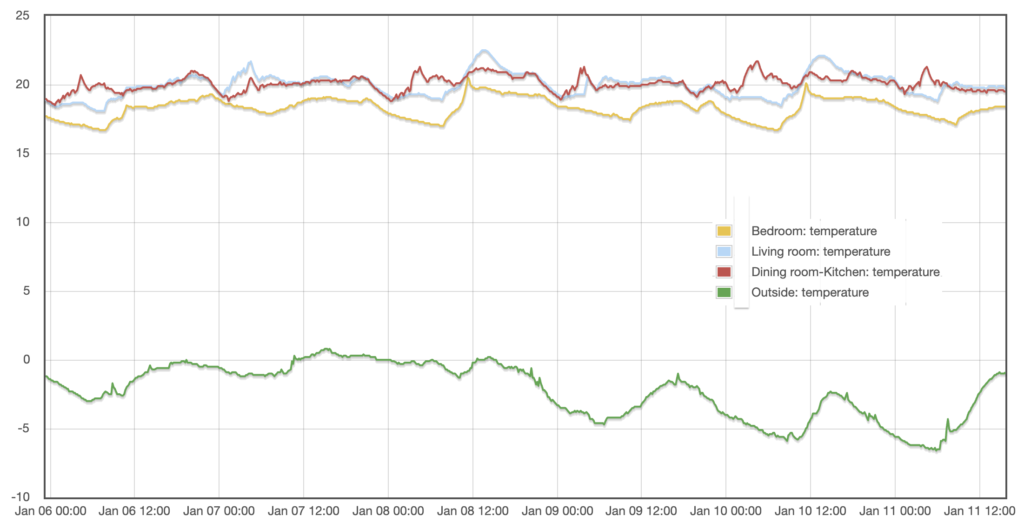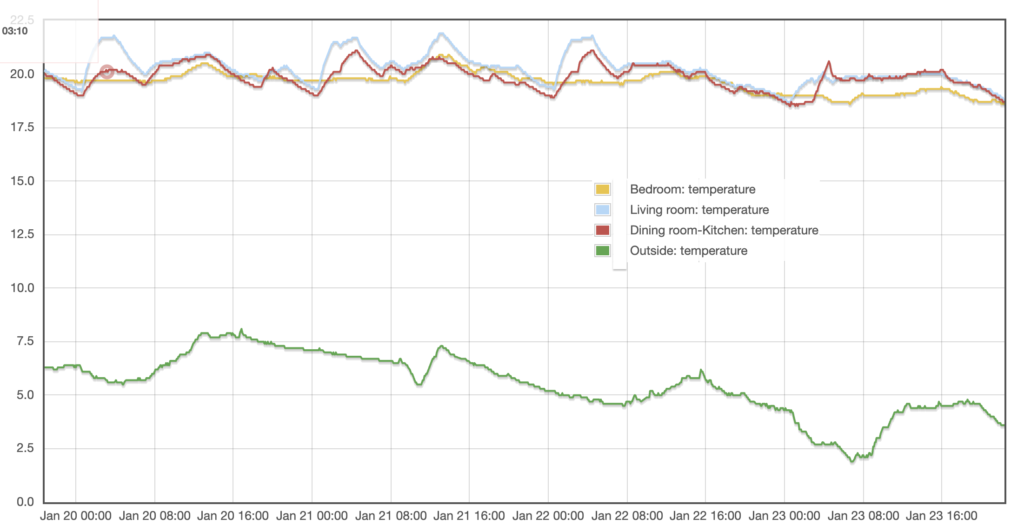Super efficient, simple and cheap heating, what's not to like?
Pros and cons of an air-to-air minisplit heat pump in a deep retrofit
In the UK, when we talk about heat pumps, we are normally talking about air-to-water (A2W) heat pumps (outside air is the heat source, heat is delivered to the home through water via radiators or underfloor heating), or sometimes ground-to-water (as above but with ground as the heat source). There also exist air-to-air heat pumps whereby the heat from outside air is delivered into the house via a fan-coil unit (a fan blows air from the room over the condenser coils). People often think these are bringing fresh air into the house; they aren't, only circulating indoor air over a heating coil. A separate system for ventilation is still needed.
The following are notes based on my own experience of using an air-to-air minisplit heat pump as the only heating over the past two years since moving back into our EnerPHit (Passivhaus retrofit) of a 1970s timber-frame house. I've not blogged for the last few years, so for a deep dive on what we did to our house, check out this podcast from the Energy Transition Show, this one from House Planning Help and this one from Building Sustainability. If you prefer videos check out this from Passive House Accelerator and this from House Planning Help. There's also a podcast I recorded with Betatalk about our experience with an air to air minisplit here.


An air-to-air (A2A) minisplit heat pump (aka an air conditioner) can work well as a very inexpensive and efficient source of heating in homes with low heat demands. In our case we have a single minisplit, located in a downstairs dining room, and this provides all the heating for the whole house. This can be coupled with a heat pump water heater (HPWH) for hot water, either ducted to the outside or taking heat from the house. Based on my experience this system has the following advantages:
- Very low capital cost (our A2A was £1,500 installed in 2023, plus £2,500 for the HPWH)
- Air-to-air mini-splits are available in smaller sizes than air-to-water units, meaning the sizing is more closely aligned with typical Passivhaus heat demands
- No space is lost to radiators
- The outdoor units of small A2A heat pumps are considerably smaller than the smallest A2W units
- It's straightforward to get to work efficiently in a very low demand house (I couldn’t find an A2W installer locally that would take me seriously about our post-retrofit heat load being under 2 kW and the things that needed to be done to get a 5 kW heat pump to work efficiently in such a house)
- Minisplits can provide cooling in summer if this is needed
- The heat pump water heater can provide ‘free’ cooling in summer if it is taking heat from the house
- The room where the heat is being delivered can be ‘overheated’ on a cheap overnight tariff, and because bedroom doors are closed these stay cooler, the temperature evens out in the morning when bedroom doors open. This enables further savings by doing a greater proportion of the heating on very cheap tariffs
And the following disadvantages:
- Less local control – in winter our bedrooms will typically be a degree or two cooler than the room where the heat is being delivered, although a degree or two cooler is often how people prefer bedrooms, so may not be a disadvantage. In very cold weather it's probably realistic/conservative to assume you'll want a bit of local direct electric heating for rooms that are far from the heat source, especially for sedentary activities (e.g. home office)
- Internal doors need to be left open for a room to receive significant heat. For us this works well for the bedrooms – we don’t mind leaving the bedroom doors open during the day, and they get enough heat this way that they stay warm enough overnight. However, this will be heavily dependent on the fabric performance of the house – our bedrooms are in the new upstairs bit of our house, so are effectively new build Passivhaus standard
- Some noticeable air movement and noise in the room where the heat is being delivered. In our house, where the heat pump is rarely working hard this is usually barely noticable (my wife comments that she genuinely never notices), but with higher heat demands it could be a problem
- Slower hot water reheat times, although this is mitigated if HWHP is taking heat from the house (rather than ducting outside)
- Imprecise thermostat (because it’s in the fan-coil unit) on A2A minisplit means the target temperature has to be adjusted to achieve the same room temperature, depending on how hard the heat pump is working. I’ve improved this by pulling the thermostat out so it is outside the unit. This has improved the situation somewhat, but it's still not very precise, I'm working on a solution to this
- Some cycling at very low loads (I'm working on a solution to this along with the imprecise thermostat)
- Ineligible for funding, and may impact eligibility for funding for other eco measures since A2A is not covered by MCS
- The limit in terms of how much heat can be delivered to the house is not necessarily the output of the unit. For our house it is how quickly the heat can get around to the rest of the house. This is not usually a problem, but after a winter holiday where we’d had the heating off for ten days it did mean a long (2-3 days) reheat time for the house to get comfortable again
- The controls and programming are not very sophisticated on my unit. I suspect because the manufacturers are not expecting people to use them as a main heat source. E.g. I can have a different programme for every day of the week, but I can’t tell the heating to stay off for two weeks and then come on 3 days before we get back from holiday (see above!). Other units might have more sophisticated controls. I’m aiming to solve this with the same solution that solves the cycling at very low loads and imprecise thermostat – stay tuned next winter!
- For higher heat loads, or more spread-out houses, consider a multi-split (one outdoor unit, more than one indoor unit). The indoor units are typically the same size for units with different heating powers, so logically they must either be running at higher flow temperatures (less efficient) or higher fan speed (noisier and more air movement); adding indoor units should mitigate this
How efficient is our system, on a seasonal basis? This is not such an easy question to answer as it is with an air-to-water heat pump, because it is much harder to measure the heat output. However, I do have separate metering of the electricity use for the air-to-air heat pump and for the hot-water heat pump, and I have the modelled heat demand from PHPP. From this I can reverse engineer a SCOP. Based on this monitoring and modelling, I estimate that I'm getting somewhere between a SCOP of 4 and 5 for space heating. If it were much higher than 5 then this would imply much higher heat demand than PHPP predicts and be hard to believe in terms of heat pump thermodynamics, and if it were much lower than 4 then that would imply truly crazy low heating demand (significantly better than PHPP predicts). An SCOP of between 4 and 5 is pretty good, up there with the best performing air-to-water heat pumps on Heat Pump Monitor. In fact, in combination with the excellent fabric performance of our house it meant our house had the lowest heating costs for 2024 of any monitored on Heat Pump Monitor! We totalled £175 for heating and hot water for the first 12 months that I had monitoring, not bad for a 1970s house so far north (near Fort William).
I've got temperature monitoring in three rooms of our house, the dining room (where the heat is delivered by the air-to-air heat pump), the living room (adjacent to this room) and the main bedroom, which is the furthest room from where the heat is being delivered. We've also got temperature monitoring for outside, although because this is under a porch it tends not to get the extremes of temperature, and it tends to lag the peaks and troughs slightly (in winter it gets a bit colder than the monitoring suggests, and in summer a bit hotter).
Here is the coldest week of the winter:

And here is a more typical winter week:

In summary, an air-to-air minisplit can work very well, and be very cheap. This is attractive for Passivhaus buildings where saving thousands of pounds on the heating system can help pay for some of the other things you wouldn't be paying for on a conventional build. However, I would be very wary of using such a system in a conventional leaky house. It works well in our house precisely because it never has to work very hard or move very much heat between rooms. In most houses I would expect an air-to-water heat pump to be more suitable.
I'll write a separate post soon on the pros and cons of hot water heat pumps and whether to have them taking heat from inside or outside the house.
Some other folk have had some useful things to say about air-to-air heat pumps. See this from John Ewbank, and this and this from John Cantor.

Hi I listened to the Beta talk podcast and am convinced that an A2A is a good choice for our retrofit. Im a PH designer also and looking to get close to EnerPHit levels. Unfortunately all quotes ive had so far are far more than your £1.5k (between £4k and £7k so far). If be interested in what unit you had installed?
Thanks
Hi James, sorry I missed this comment. Our unit is the smallest in the Mitsubishi SRK-ZSX-W range. Indoor unit was SRK20ZSX-W and outdoor unit was SRC20ZSX-W. I think it would be worth paying for a more expensive unit if it had better control than mine.